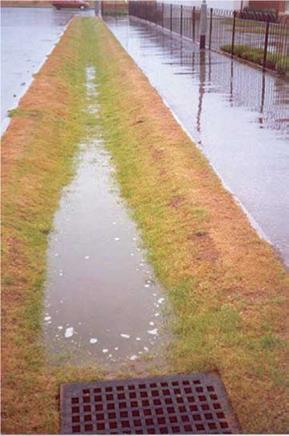Runoff
Runoff derives, principally, from rainfall falling on the pavement and surrounding ground. Although surface water drainage falls outside the scope of this book, runoff becomes of interest as some soaks in through cracks or through pervious surfacings. The proportion soaking-in will vary depending on the rainfall pattern, road surface quality and the permeability of the road’s margins and surrounding earthworks. At the margins the water should be routed into a drainage system. If a positive drainage system is provided then kerbs or gullies will intercept the surface flow and feed it to gulley pots and/or a piped drainage system. From there, water may be fed to some disposal system – this may be a soakaway to the ground or it may be to a surface water course. Normally road runoff will be given some treatment before it is disposed. Treatment will usually include solids settlement and oil separation.
In areas where land is available, the runoff may be fed into an open, vegetated, lateral ditch known as a swale (see Figs. 1.10 and 1.11). These can form part of “SUDS” (Sustainable Urban Drainage Systems). Together with filter strips, infiltration trenches and basins, porous pavement surfaces, constructed wetlands (e. g. reedbeds) and detention and retention ponds, they tend to act as natural attenuators of contaminants that will be sorbed into the ditch lining and taken up into the vegetation which, periodically, can be cut and removed. They also act as sediment traps, removing suspended solids. Excess water that does eventually arrive at a surface water course, or that soaks down to the water table, will usually be relatively
 |
 |
clean due to the natural attenuation processes encountered en route. However, this means of treating and disposing of water that potentially contains contaminants cannot be used unthinkingly. There are many natural environments that are “highly vulnerable”. High vulnerability exists when a near-highway environment can be easily polluted by runoff water (for example, where seeping water provides drinking water or sustains a quality ecosystem). The rare, but critical, occurrence of an accidental spillage, e. g. following a tanker crash, can cause acute effects to down-gradient waters.






Leave a reply